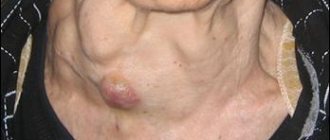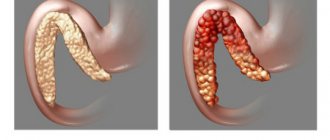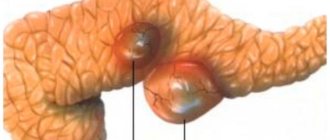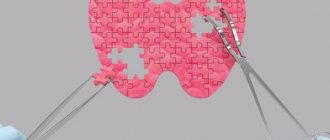Thyrotoxicosis is an extreme degree of increased production of thyroid hormones, leading to significant changes in a person’s condition and appearance. And the increase itself is called hyperthyroidism.
Our expert in this field:
Tafintseva Ekaterina Anatolevna
Head of hospital, general practitioner
Call the doctor
Thyrotoxicosis is not a disease, but a syndrome associated exclusively with increased production or excessive entry into the blood of thyroid hormones; it goes away when they normalize, not to say completely without a trace, but with almost no losses. One person in a hundred adults suffers from this syndrome.
Hyperthyroidism to any degree can occur when the thyroid gland is destroyed as a result of diseases, usually of an inflammatory autoimmune nature, and in some of its diseases. Most often, nodular goiter and toxic gland adenoma lead to hyperthyroidism. Thyroid hormones can produce some malignant tumors and metastases of thyroid cancer located in any organs and tissues. The condition of hyperthyroidism can be induced by an overdose of synthetic thyroid hormone tablets.
How the last one became the first
People have known about goiter for a long time; it was impossible not to notice the bulge on the neck. But it was somehow impossible to combine a goiter with a parallel heartbeat and bulging eyes. In 1722, the French physician Charles de Saint-Ives reported to the competent medical society at a scientific meeting about bulging eyes with palpitations, although without any connection between one and the other.
Eight decades later, this observation, supported by the medical histories of two patients, was made by the Italian doctor Giuseppe Flaiani, who also did not see any connection between the symptoms and each other. And not only did they describe, but did not connect, all researchers did this. They remained in the history of endocrinology, and the name of the Welshman Caleb Hillier Parry, who in 1786 described eight cases of a combination of goiter with palpitations and bulging eyes, the connection of which he noticed and noted, was forgotten.
In 1834, the Irishman Robert James Graves wrote a two-page article describing three cases of palpitations with an enlarged thyroid gland, where the main thing was not the gland at all, but the root cause - heart disease, and became famous. And four years later, the doctor of the small Saxon town of Merseburg, Karl von Basedow, with special care describes everything that all his predecessors wrote about for 120 years: goiter, palpitations and bulging eyes, which later became known as Basedow’s disease. But after World War II, English became the means of international communication, so in English the condition was called Graves' disease.
Over the course of a century and a half of official existence, thyrotoxicosis has had more than two dozen names. They used different options around Basedov: pseudo-based, para-based, based-based, pre-based. But more often they relied on the primary principle - the thyroid gland, adding to the “thyroid” the second part, which seemed the most important to the researcher of the disease: neurothyroidism, thyroneurosis, thyroidism, dysthyroidism, hyperthyroidism.
Soviet endocrinologist Nikolai Adolfovich Shereshevsky “for internal use” proposed calling hyperproduction of thyroid hormones thyrotoxicosis, which was as close as possible to clinical reality.
We will call you back
Leave your phone number
How do thyroid hormones work?
Hormones produced by the thyroid gland are extremely important for any cell in the body, so their excess, as well as their deficiency, causes dysfunction of all body systems. The thyroid gland itself carries out its activities according to instructions from above - from the brain, where the hypothalamus “takes” blood tests, determining the concentration of all circulating hormones in it, and the production of the thyroid gland is no exception.
The hypothalamus sends information about the exact content of hormones in the blood to the pituitary gland, which provides feedback to the endocrine glands, sending them orders to increase or decrease the production of a particular hormone. The thyroid gland also receives a “letter” from the pituitary gland in the form of thyroid-stimulating hormone (TSH). TSH is released cyclically, during stress - more, at night - less.
The thyroid gland in its cells “cooks” two types of hormone from iodine and the protein tyrosine supplied with food:
- With four iodine atoms - tetraiodothyronine (T4) or thyroxine,
- With three iodine atoms - triiodothyronine (T3).
T4 is produced two-thirds, and T3 - one-third, it is not very stable, T4 is much stronger, and it is not a completely ready-to-use hormone, because in cells T4 discards the iodine atom, turning into T3 - the main instigator of all metabolic cellular processes.
Both hormones T3 and T4 accumulate and are stored in gland cells in a “packaged” form - thyroglobulin, very similar to jelly. When there is a signal from the pituitary gland, hormones leave the gland cells and are delivered by blood to where they need to be, where hormones play a vital role in all metabolic processes, and for them there are special receptors on every cell of the body that help them penetrate inside as quickly as possible.
Increased thyroid hormones
An excess of hormones is possible when there is a malfunction in the activity of the thyroid gland itself - primary hyperthyroidism or when there is a violation in the regulation of its function on the part of the brain - secondary.
In nine out of ten cases of hormone overproduction, the cause lies in the development of diffuse goiter or Graves-Basedow disease, when immune cells begin to produce antibodies to receptors on the surface of the thyroid gland, forcing the synthesis of hormones. The gland itself grows, trying to fulfill the instructions, as it believes the hypothalamic-pituitary system, not suspecting that it is being misled by immune cells.
A focus of autonomous regulation can form in the thyroid gland - an adenoma that synthesizes hormones. Adenomas are classified as benign tumors, but a formation that produces any biological substance can provide a very malignant service to the body. Moreover, thyroid adenoma does not require orders from the central nervous system at all; it decides whether or not to give it hormones and how much to do.
After some short time after any viral infection, inflammation of the thyroid gland may develop - thyroiditis . Having entered the thyroid tissue during its spread through the bloodstream through the organs, the virus triggers the synthesis of protein structures that are not quite familiar to the body, which are attacked by the body’s immune defenders. Together with the incorrect proteins, the gland cells in which the proteins were enclosed die. When a gland cell ruptures, all its contents are released into the blood, including hormones. When inflammatory and damaged cells become scarred, temporary hyperthyroidism gives way to permanent hypothyroidism.
Diagnostics
Characteristic symptoms are supported by tests for the level of thyroid hormones and thyroid-stimulating hormone (TSH), respectively, T3 and T4 are high, and TSH is low. Specific antibodies to the TSH receptor are detected in the blood.
An ultrasound or CT scan of the thyroid gland determines the root cause that led to the development of hyperthyroidism. If an adenoma is suspected, scintigraphy is performed.
CT and MRI are required to determine the presence of a retrosternal component of the thyroid gland; it happens that on the neck the gland is of normal size, and additional glandular tissue can spread behind the sternum, pushing aside the trachea and esophagus. If there is a node in the gland, its puncture is performed.
Folk remedies
Photo: narrecepti.ru
If appropriate symptoms appear, you should immediately seek help from a specialist, who, in turn, will prescribe all the necessary diagnostic measures and specialized treatment. In no case should you self-medicate, since the progression of the pathological process can lead to the development of complications that are much less amenable to correction.
On the Internet you can find various recipes for decoctions based on medicinal herbs. Most sources use the following combinations of herbs:
- catnip herb, white cinquefoil roots, oregano, mint, lemon balm and motherwort;
- motherwort, valerian root, hawthorn and mint;
- hop cones, valerian root and mint;
- seaweed, horsetail, smokeweed, plantain, pine and walnut.
As a rule, such funds are used for 1 – 2 months. However, it is worth noting once again that in no case should you self-medicate, since traditional medicine does not have an evidence base.
The information is for reference only and is not a guide to action. Do not self-medicate. At the first symptoms of the disease, consult a doctor.
Treatment of thyrotoxicosis
The goal of therapy is to normalize the production of thyroid hormones, which is achieved with medications - synthetic hormones and treatment of the disease that causes disruption of hormone production.
In most patients, after a month of therapy, the hormonal level returns to normal, the treatment will be constant for a year and a half, and the observation of an endocrinologist is also constant to adjust the dose of the drug, with the possibility of subsequently stopping the antithyroid drug.
If there is no effect of therapy, relapse of thyrotoxicosis, or severe toxic reactions to drugs, the question may arise of destroying part of the glandular tissue using surgery or radioactive iodine.
Our doctors
Mikhailova Elena Vladimirovna
Endocrinologist, diabetologist, candidate of medical sciences
Experience 46 years
Make an appointment
Slovesnova Tatyana Alekseevna
Endocrinologist, Candidate of Medical Sciences, doctor of the highest category
Experience 48 years
Make an appointment
Kolodko Inna Mikhailovna
Doctor - endocrinologist, doctor of the highest category
Experience 26 years
Make an appointment
You can undergo a course of treatment for thyrotoxicosis in the endocrinology department of the CELT clinic. We have modern equipment and drugs that allow us to guarantee the desired results.
Symptoms
Medical students do not need a cheat sheet to remember the symptoms of thyrotoxicosis. They are helped out by a counting rhyme that contains the main criteria of the syndrome: the heart is beating, the whole body is shaking, the eyes want to pop out. It is not for nothing that all researchers before von Basedow noted cardiovascular pathology; it is becoming dominant. First of all, hyperthyroidism is manifested by rhythm disturbances - arrhythmias, first transient extrasystoles - unscheduled heart contractions. As hormone levels increase, isolated interruptions are “combined” into groups of two or three unscheduled attacks.
With an extremely high concentration of thyroid hormones in the blood, thyrotoxicosis syndrome appears on the scene with serious rhythm disturbances - atrial fibrillation. Fibrillation represents an irregular, irregular contraction of the atria, when each muscle bundle of the myocardium obeys its own ri. On an ECG, fibrillation looks like saw teeth of different sizes. It is clear that with such a contraction the atrium is not capable of adequate functioning.
If left untreated, thyrotoxicosis forces the heart into a permanent form of atrial fibrillation. This causes stagnation of blood in the atria and the formation of blood clots that disperse and block the pulmonary vessels, vessels of the brain and other organs. With prolonged arrhythmia, the heart muscle becomes loose and stretched.
The elastic myocardium turns into a thin-walled, barely quivering sac. This is already dilated cardiomyopathy with its inevitable heart failure: shortness of breath, edema, and so on. Against the background of cardiovascular hormonal “leprosy,” dysfunction of other organs is no longer so noticeable.
Take care of yourself, book a consultation now
In the clinical picture of thyrotoxicosis, a somewhat inadequate nervous reaction of the patient to ordinary life is noticeable. The patient suffers from emotional lability, that is, anxiety and fussiness easily and without any reason turns into excitement. If there is a reason, the person directly explodes. He may cry and laugh, but not to the extent that circumstances require, but too actively. He finds it difficult to concentrate and sleep is disturbed. With nervousness and internal “grossness,” a person is bothered by severe weakness and profuse sweating in response not only to an uncomfortable temperature, but also for no reason. There is a constant feeling of internal trembling and trembling of the hands - tremor. In a state of stress, the hands also tremble, but with thyrotoxicosis they tremble almost constantly, and in severe cases the whole body shakes.
Almost half of the patients begin to become “big-eyed.” Not immediately, but over time, the eyes roll out more and more, but the vision remains the same. As a rule, the patient does not notice this trouble much, since he sees himself in the mirror every day, and changes in the eyes come gradually. But episodic pain somewhere behind the eye does not pass by; pain is also possible with certain eye movements.
The eyelids swell, their skin thickens and becomes slightly inflamed, the mucous membrane of the eye is streaked with small vessels and turns red, natural and therefore imperceptible to a healthy person eye movements become very noticeable. These are signs of endocrine ophthalmopathy, starting with inflammatory swelling of the tissue around the eye and the muscles that move the eye, and then the formation of scar tissue in them.
Ophthalmopathy does not correlate with an increase in the level of thyroid hormones, and can develop against the background of their increase - hyperthyroidism before the onset of thyrotoxicosis. Therapy leads to a significant reduction in bulging eyes, but, unfortunately, not to the original appearance.
Complications of hyperthyroidism
If the course of hyperthyroidism is unsuccessful, a thyrotoxic crisis may occur, provoked by great physical stress, stress or infectious diseases, then all the symptoms of hyperthyroidism intensify to:
- severe tachycardia with signs of heart failure;
- swelling and severe exhaustion;
- fever, delirium, etc.
Further progression of the thyrotoxic crisis may result in the patient's coma and death. Another version of the crisis - apathetic - occurs with the development of indifference, apathy, and cachexia. It is noteworthy that thyrotoxic crisis occurs only in women.
In connection with this circumstance, experts distinguish between three and five stages of hyperthyroidism, which are more correctly called degrees.
Additional clinical signs
Enlargement of the thyroid gland itself—goiter—is observed in six to seven out of ten people. Muscle weakness often develops, and the enhancement of bone formation processes by hormones leads to thinning of bone tissue - osteopenia, since the process of destruction always overtakes the process of bone formation. All processes in the body go faster, so nails and hair break easily, the skin epithelium dries and exfoliates, and weight decreases.
Diarrhea is quite rare in thyrotoxicosis, but occurs in older patients with other concomitant chronic diseases. Fertility suffers, but menstrual irregularities are less common. In principle, a woman is able to become pregnant and give birth, but one in a hundred babies born may develop thyrotoxicosis due to the passage of antibodies to the thyroid-stimulating hormone receptor into the fetal blood.
The material was prepared by Ekaterina Anatolyevna Tafintseva, a general practitioner and head of the hospital at the Medicine 24/7 clinic.
Psychological provocateurs
All people experience stress to varying degrees, but thyrotoxicosis does not occur in one hundred percent of cases. To explain this fact, a psychological portrait of the person who is more susceptible to the disease was compiled. The patients were characterized by the following character traits:
- excessive independence, refusal of outside help;
- willingness to exceed the task at any cost;
- tendency to hide one’s feelings, weaknesses and fears;
- desire for success, work and excessive responsibility.
In childhood, such patients were artificially forced into the role of an adult, for which they were not ready . Most often these are older brothers and sisters in a large family. For women, an alternative to professional success may be the desire to have as many children as possible.











